Actionable data is the key to success for an ecommerce store. If you have been running an online ecommerce business, then you might already know the importance of data-driven ecommerce marketing. Unless you can collect, monitor and process your store data into actionable items, you can forget about improving the engagement, click through rate and business revenue.
How can you best track insightful data to optimize an ecommerce business?
The most traditional answer has been ecommerce tracking in Google analytics. Shane Barker, in one of his posts, wonderfully elaborated the benefits and process of setting up Ecommerce tracking in Google Analytics. If you are a startup store, then setting up ecommerce tracking is a must for keeping a check on your store’s performance.
While the basic ecommerce tracking in Google Analytics effectively summarizes which products are succeeding and which ones are not. It doesn’t really provide key insights into the actual customer journey. Hence, the mystery as to why some products are unsuccessful and how can you sell more of the ones which are succeeding remains unsolved.
This is where Google's Enhanced Ecommerce analytics lets you dive deeper into the sea of customer data and fish out everything you need to analyze customer behavior on your website.
Google's Enhanced Ecommerce Analytics: Why It Is Important?
If you think from a customer’s perspective, there are several potential courses a customer may take before actually making a purchase. They might add items to a wishlist before purchasing and even visit the product page 10 times to review the product details thoroughly.
Their actions could be driven by diverse propensities such as comparing product prices on competitor websites, waiting for a discounted price, waiting for a product to be in stock again, etc. For marketers or business developers like yourself, it is necessary to gain insights into the customer journey to determine which area in the business needs optimization.
Enhanced Ecommerce lets you get your hands on actionable data which is generated by tracking the entire customer journey of a visitor.
How Enhanced is Enhanced Ecommerce Tracking?
Traditional ecommerce analytics relied upon a goal to be accomplished (in most cases a purchase made) to generate data like:
The conversion rate for a product. Total sales value of the product. Quantity sold. Total Impressions.With Enhanced Ecommerce, you don’t have to be limited in terms of your tracking. It allows you to track the minutest of details which acts as necessary queues to optimize your store.
This includes:
Customer behavior
Customer engagement
Product performance reports
Cart abandonment rates and causes
Coupon and discount performance
Detailed affiliate reports
Refund reports
Content marketing reports
When compared side by side, the difference between what you can achieve through both versions of Google Analytics ecommerce tracking is staggering.
Enhanced Ecommerce doesn't just let you monitor the performance of products and analyze the sales funnel; it also aims to provide you much deeper behavioral insights so you can optimize that funnel by enhancing the user experience as well as your marketing plans.
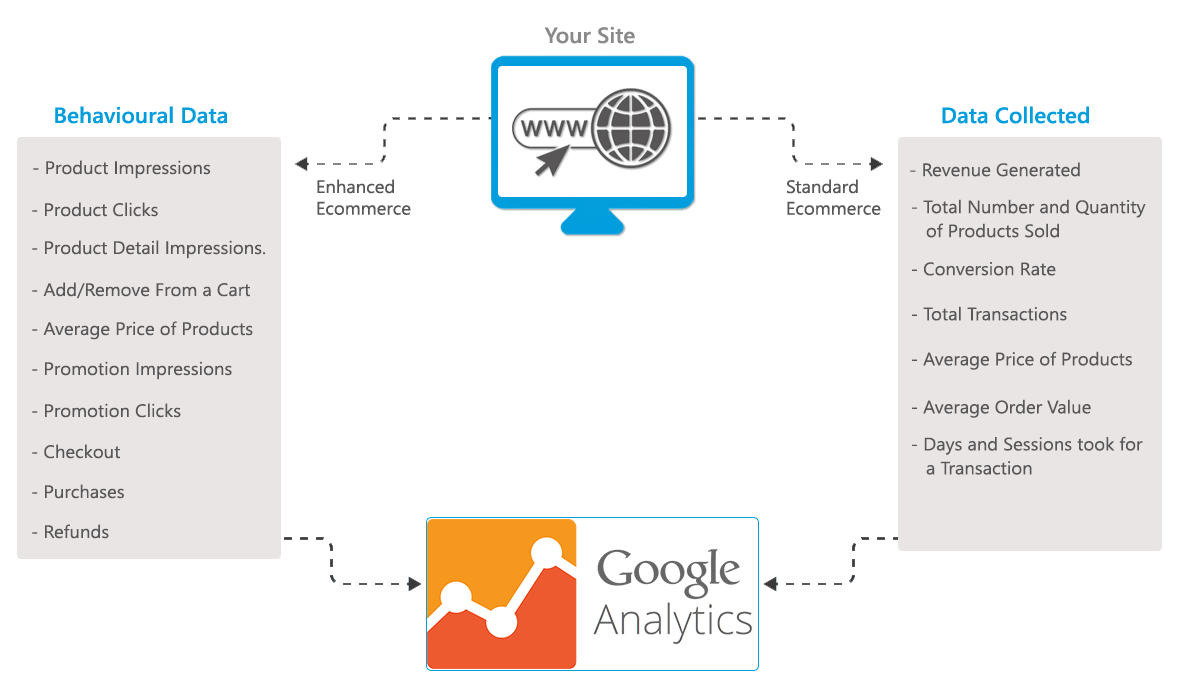
Enhanced Ecommerce Data Types
To assist developers in identifying the type of data they are looking to track, Google has grouped different data types into four categories. These categories let you identify what data you can track and the relevant values in a data layer that are captured based on a trigger.
These categories are:
Impression data: Provides complete information about a product that has been viewed by a customer.
Product data: Provides complete information about individual products that are viewed.
Promotion data: Provides complete information about the promotional elements/banners you have used on your website.
Action data: Provides complete information about all ecommerce actions happening on the website.
Check out the Google Analytics tracking guide for a detailed list of all the individual data types that can be tracked under each of these categories.
Now that you know what you can track with Google Analytics, the next step is to implement Enhanced Ecommerce Analytics and use it to send the analytics data back to Google Analytics from your store.
This is where things get a bit ‘tedious’ — especially when you are running a store with a huge database of products and categories.
Implementing Enhanced Ecommerce Analytics
The functionality to set up Enhanced Ecommerce has been around for quite some time, but there are countless stores which still consider it as a secondary option, hence missing out on tons of valuable data that can take their marketing strategy to the next level.
The reason could most likely be the fact that the setup process is a bit complex, and yes it demands basic knowledge of JavaScript as well.
The Prerequisites
Enhanced Ecommerce Analytics can only be activated utilizing either Universal Analytics or Google Tag Manager (GTM).
While most of the world has already moved onto Universal Analytics (if not Google Tag Manager), some are still using classic analytics. If this is you, then it is time that you upgrade to either, and discover what you have been missing out on.
Activating Enhanced Ecommerce Using Universal Analytics
If you are using Universal Analytics, then you will have to activate the EC.js or the Enhanced Ecommerce plugin manually. The plugin code, which activates the plugin, is specified right after your Google Analytics UA code, followed up with plugin commands to track data and send it over to Google Analytics.
When implemented, the flow appears to be as follows:
The first step is to define your UA tracking code >>
ga(‘create’, ‘UA-XXXXXXXX-X’, ‘auto’); Next comes the command which activates the Enhanced Ecommerce plugin >> ga(‘require’, ‘ec’); Follow it up with specific plugin commands to track impressions such as (‘ec:addImpression’)Clicks on products
(ec:addProduct)followed with...
(‘ec:setAction’, ‘click’) Then, in the bottom use the send command ga(“send”, “”, “”,)to send this data to Google analytics. You can send multiple data types such as
ga(“send”, “event”, “detail view”, “click”, “addtocart”)based on the user journey.
It is necessary to implement the codes in exactly the same order otherwise the tracking will fail.
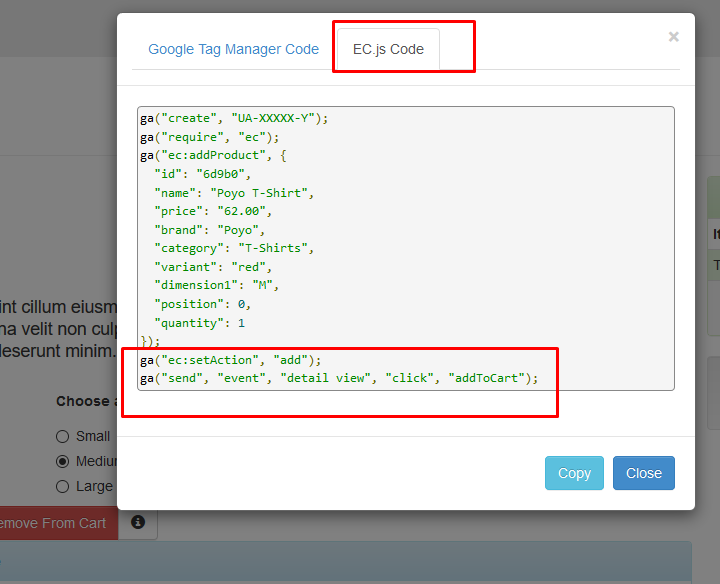 Screenshot from Google’s Enhanced Ecommerce demo store explaining how to set it up with UA code to capture an “Add to cart” event.
Screenshot from Google’s Enhanced Ecommerce demo store explaining how to set it up with UA code to capture an “Add to cart” event.
Activating Enhanced Ecommerce Using Google Tag Manager
If you have set up analytics using Google Tag Manager, then the process to set up Enhanced eCommerce gets a bit more complex with a few more steps added to it. The fundamental idea behind using GTM for enhanced tracking is to set up multiple data layers throughout your website that temporarily store the data rendered on each page of the store.
These data layers are hardcoded in various page elements throughout the store, for example, product click, add to cart, remove from cart, add to wishlist, etc. Depending upon the number of product pages in your store, you might have to create hundreds of data layers.
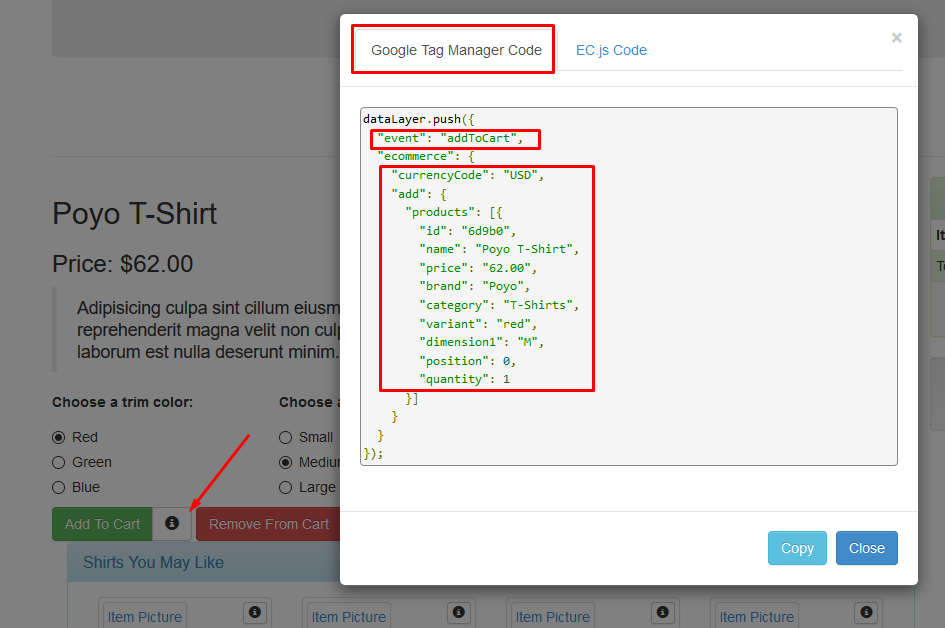 Screenshot from Google’s Enhanced Ecommerce demo store explaining how data is pushed into a data layer for an “Add to cart” event.
Screenshot from Google’s Enhanced Ecommerce demo store explaining how data is pushed into a data layer for an “Add to cart” event.
This data is then retrieved by the variables pre-defined in your GTM account using tags which are fired based on the triggers that you define in your Google Tag Manager account.
From these variables, the tracking data is cumulatively sent to Google Analytics where it gets converted into actionable metrics. The GTM developer guide summarizes the specific data layers required for different pages of a website — something everyone must follow to set up relevant data layers.
Once you have coded the relevant layers for your ecommerce store and have set up relevant triggers and tags to retrieve data from those data layers, enable enhanced reporting in your GA or tag manager account and set up relevant checkout labels to track your data.
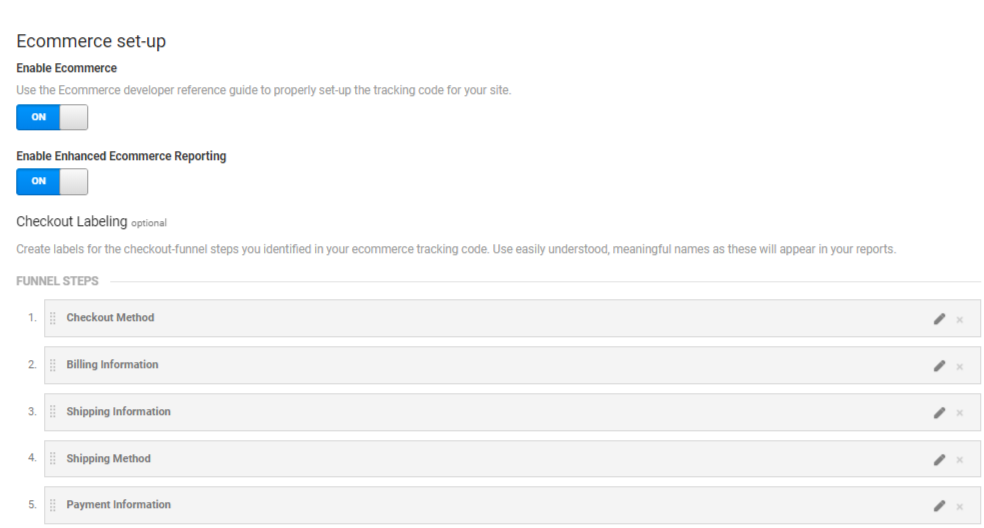
Make sure to add meaningful checkout labels as these will eventually be used to determine the success rate of your checkout. Using these labels, you can track the behavior of your customers on different steps of a checkout. This data is collected and displayed in the checkout behavior option as shown below:
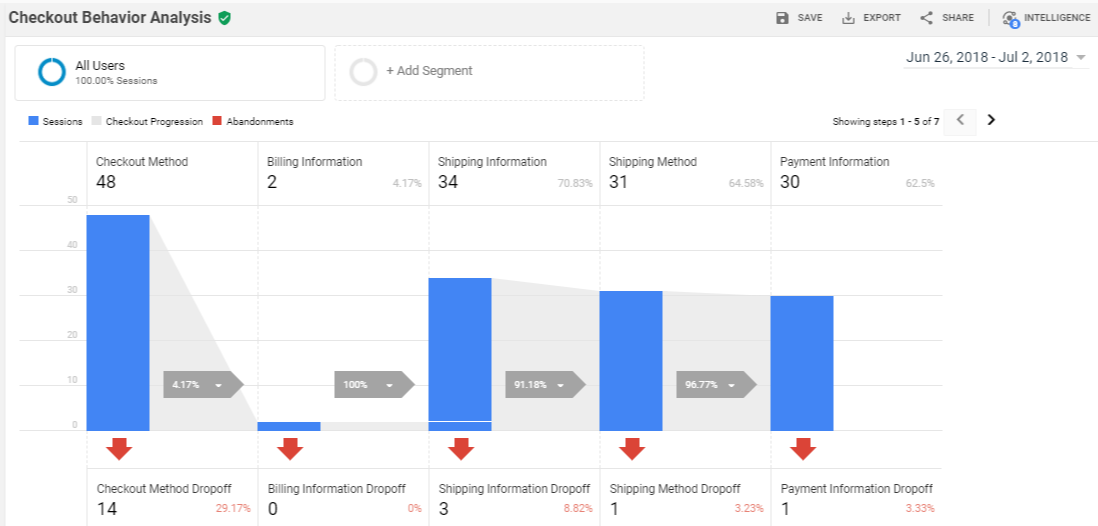
Whether you follow the Universal Analytics approach or the Google Tag Manager approach to enable Enhanced Ecommerce tracking, you will end up hardcoding the tracking snippets (either for GA or GTM).
We would like to refer to Google’s demo store once again for highlighting how different areas require the data layers to be set up for receiving information from the ecommerce store in GA.
Product Listing Page
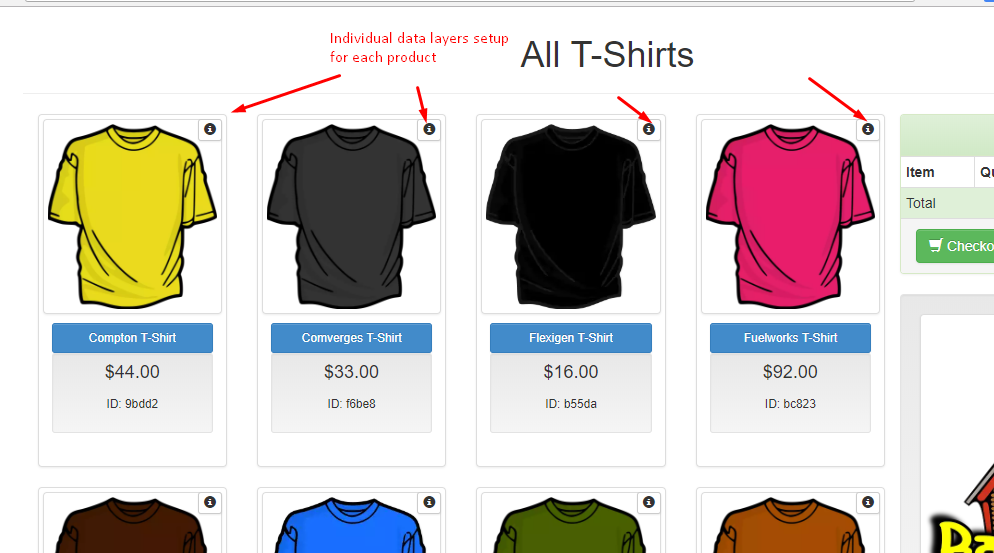
Product Detail Page
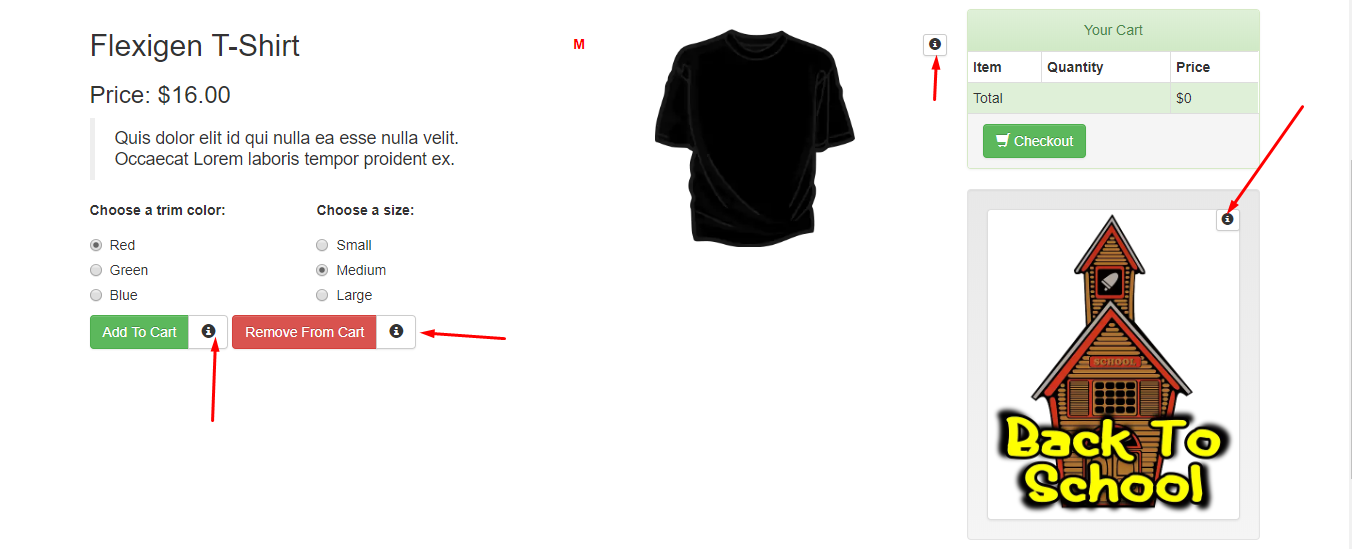
Managing Entire Stores
While the demo store above only consisted of a small amount of data that was easy to comprehend, dealing with a complex ecommerce store manually increases the difficulty by many folds. As the whole process involves implementing the correct tracking snippet or data layer throughout the entire store, it can get really tricky to set it up flawlessly. There are two ways to get this done:
1) Using a 3rd Party Plugin for Your Ecommerce CMS
Major CMS systems already feature plugins in their marketplaces which can get the job done automatically. By simply installing the plugin and integrating it with your Google Analytics account, you can enable or disable the impressions, actions or elements that you want to track.
Some reliable plugins that we have worked with in the recent past include:
Magento: Google Analytics Enhanced Ecommerce
Shopify: Actionable Google Analytics
WooCommerce: Enhanced Ecommerce Google Analytics Plugin
2) Manually Implementing the Data Layers
Even though major platforms do provide plugin support, you may encounter a scenario where your CMS doesn’t have a plugin yet (E.g., BigCommerce or OpenCart), or you have a custom built an ecommerce store using a Framework like Codeigniter or YII.
In such instances, we recommend hiring professional developers for implementing the code snippets or the data layers in precise locations for your store.
Testing Your Implementation With Google Tag Manager
It is essential to test your implementation before and after implementing it on your live website as there is always a chance of an underlying bug with the Enhanced Ecommerce implementation.
Testing Enhanced Ecommerce tracking before publishing GTM container:
Google Tag manager features a Preview and Debug mode that enables a console editor on top of the website where you aim to publish your GTM container. The console is visible only within the browser where you have enabled Preview mode.
With the Preview and Debug mode, you get access to all 4 elements of a GTM account:
Event Timeline: Lists all the page load events that occur till the point page is rendered inside your browser.
Tags: Lists all the tags which were added on the page, the ones which were fired and the ones which failed.
Variables: Lists detailed information about different variables collecting data in the selected event, including the type of variable, the type of data returned, and the resolved value.
Data Layer: Gives a preview of the exact data layer along with all the data that was generated for the specific event.
Testing Enhanced Ecommerce tracking after making it live:
Testing tracking after publishing the Google Tag configuration is also as important as testing it before making it live.
The best way to test Google Tag Manager configuration and to test whether it is still supplying data to Google Analytics effectively or not is by Installing Google Tag Assistant Chrome extension.
The extension allows you to record your session on the website and generates a thorough report on all the events that were triggered along with how they will be reported in Google Analytics.

Once your test cases generate positive results, you are all set to publish your GTM container. Now all you need to do is remove the traditional ecommerce tracking code from the checkout page and publish your tag configurations.
What We Learned From Implementing Enhanced Ecommerce Analytics
In our most recent SEO assignment, we were tasked with the responsibility of setting up the enhanced analytics for a Magento powered ecommerce store; a store where Google Tag Manager was being used to generate standard ecommerce analytics.
The store had over 150 categories and housed over 10,000 products in its inventory. And, implementing the tracking code manually turned out to be a time-consuming task (if not technically challenging). Our initial attempt to manually set up tracking for various events resulted in disappointment as one or the other test cases kept generating negative results.
We even consulted Google’s support team to help us with our implementation (Note: They do listen and actively reply back), but even they faced a tough time getting things right. The core reason was the store size and placing the data layer code in precise locations manually turned out to be a puzzle. Even though we were successfully able to set up a couple of data layers for tracking product and advertisement impressions, it consumed a lot of man-hours.
Eventually, the conundrum was resolved by utilizing an off the shelf plugin from the Magento marketplace. By configuring the extension, we were able to see the desired results.Conclusion
As a takeaway from this blog, we would always suggest going for a plugin if your CMS supports one. Implementing Google's Enhanced Ecommerce on a store comprising of multiple categories and product will definitely give a headache to even the most experienced of developers. You can always save time by hiring a developer to configure a plugin for you.
Setting it up is definitely challenging. However, it is indeed worth all the effort as the results will bring in to light some key insights which will help you making business decisions more effectively.
Do you have any queries about implementing enhanced analytics or have you already implemented it for your business? Did you face any challenges and how did you work around those challenges? Do share your experiences in the comment section below.
Innovative SEO services
SEO is a patience game; no secret there. We`ll work with you to develop a Search strategy focused on producing increased traffic rankings in as early as 3-months.
A proven Allinclusive. SEO services for measuring, executing, and optimizing for Search Engine success. We say what we do and do what we say.
Our company as Semrush Agency Partner has designed a search engine optimization service that is both ethical and result-driven. We use the latest tools, strategies, and trends to help you move up in the search engines for the right keywords to get noticed by the right audience.
Today, you can schedule a Discovery call with us about your company needs.
Source:





